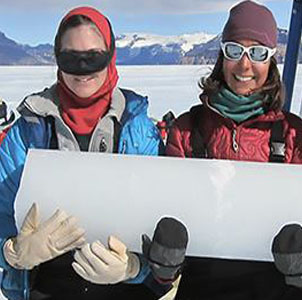|
Glacier "Tree Rings" Could Hold Clues for Planet's Future 
National Science Foundation Posted March 20, 2019 Image: Courtesy of Sarah Aarons / University of Chicago Buried in the ice of Antarctica are records of what Earth looked like 130,000 years ago, when the glaciers last melted—and what it might look like again in the future. As ice was laid down in successive layers from previous years, it acted like tree rings, recording weather patterns and circulation as Earth cycled through colder and warmer periods. In a new study, OPP-funded scientists found that volcanic dust embedded inside the ice samples suggests that the West Antarctic Ice Sheet collapsed during the last warm period 130,000 years ago—which researchers are eager to know because a similar collapse today would have major implications for the world’s population. “There is some evidence from coral reefs that suggests the oceans were 16 to 30 feet higher during the last interglacial period then than they are today, so people really want to know where that extra water came from,” said Sarah Aarons, a University of Chicago postdoctoral researcher who led the study, which was published online last month in Geophysical Research Letters. Read more in a university news release here: https://news.uchicago.edu/story/glacier-tree-rings-could-hold-clues-planets-future The work was supported by this collaborative NSF award: https://www.nsf.gov/awardsearch/showAward?AWD_ID=1246702
|



For USAP Participants |
For The Public |
For Researchers and EducatorsContact UsU.S. National Science FoundationOffice of Polar Programs Geosciences Directorate 2415 Eisenhower Avenue, Suite W7100 Alexandria, VA 22314 Sign up for the NSF Office of Polar Programs newsletter and events. Feedback Form |
